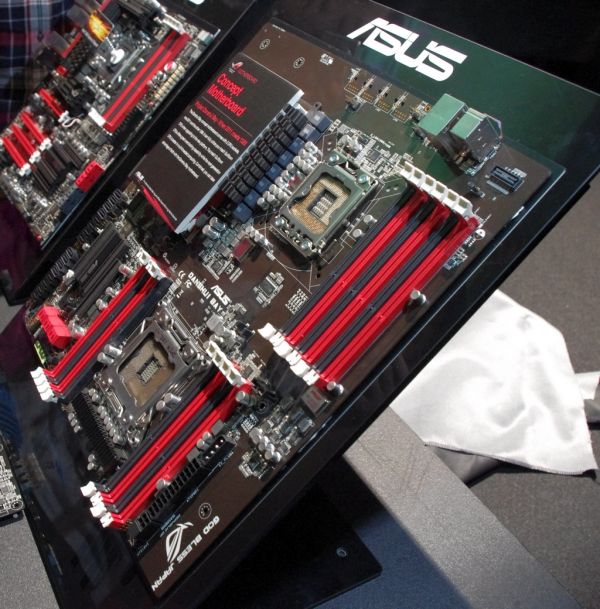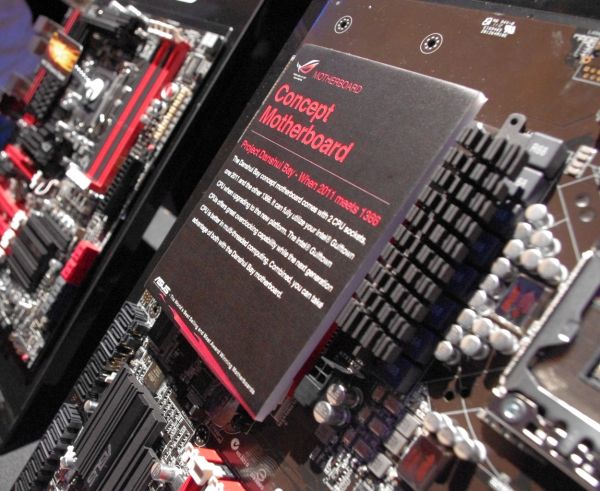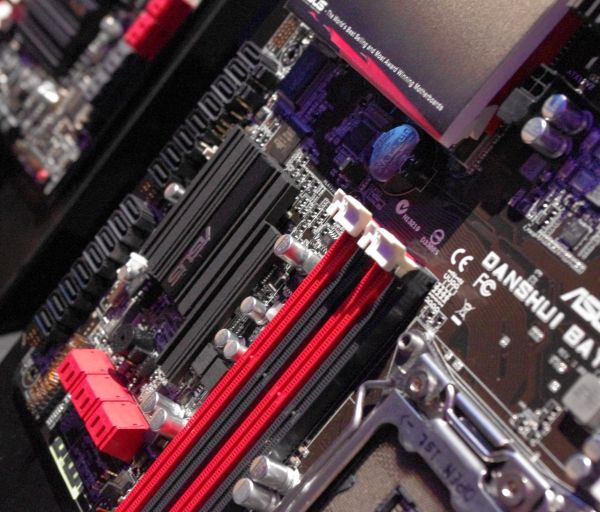Computex 2011: Danshui Bay Concept Motherboard
by Ian Cutress on June 3, 2011 7:53 PM EST- Posted in
- Computex 2011
- Motherboards
- M1000
- Asus
- Trade Shows
ASUS have been coming to Computex to sensationalize and dazzle the press with concepts for years, and this year is no different, regardless of whether something is technically feasible or not. Last year, we saw the ASUS Immensity motherboard concept that was never put into production – an X58 featuring a 5450-type integrated GPU and a Lucid Hydra chip to combine any discrete GPU combination on board. This year takes a turn for the surreal.
Introducing the Danshui Bay concept:
Simply put, ASUS are wanting to combine two chipsets on one motherboard – the X58 socket 1366, and the X79 socket 2011. If we completely disregard the technical challenges this faces, it provides the interesting idea of something that might be possible in the future: You want to upgrade your machine to the latest chipset and processor. Rather than throw your old processor away or sell it on, you could buy a motherboard that lets you harness the power of the old processor and a new processor together, in some form of chimerism.
As for the technical challenges in producing such a product, I could reel off a whole list. For a start, chipsets are not designed to talk to each other. Processors need dual QPI links to talk to each other of the same model – how that would work with different socket processors with different caches and core counts is also a mystery, as with 1366 you would need an appropriate Xeon. With two chipsets, you’ll have to have a different set of memory for each processor, and possibly getting a mismatch there based on dual/tri/quad channel memory. Each processor requires its power and a set of PCIe each – unless you disregard the PCIe of one of the chipsets but then you would have to have at least the processor of the other socket in order to run a discrete GPU. The same goes with SATA ports, I/O connectors, USB headers, and so on.
Obviously, this board presented is a mockup – merely bits and pieces put together. It’s showing sixteen SATA 3 Gbps and six SATA 6 Gbps for a start, as well as no significant power delivery and an obscene form factor. ASUS only want to know that if there was a demand for such a product, despite the technical limitations.



















52 Comments
View All Comments
tynopik - Saturday, June 4, 2011 - link
No it doesn'tparse the marketing speak carefully
'fully utilize your Intel Gulftown when upgrading to the new platform'
by buying their board, you are upgrading to the 'new platform' (socket 2011) but can still use your Gulftown
they are in no way saying you can use a socket 2011 and socket 1366 cpu simultaneously
vol7ron - Saturday, June 4, 2011 - link
I was thinking the same thing; two sockets, but not simultaneous.I have to disagree that this is the "stupidest idea a manufacturer has presented", in fact, it's something I've been looking for to some degree.
Whenever I upgrade something, I essentially build a high-end new box and keep it for a few years til it's time to build another new box. Instead of building highends, I could build a mid-end until the high-end proc prices come down and then upgrade to that, instead of the whole box. Instead of missing phases of releases, I can have continual upgrades.
Example: use my 1366 now, when 2011 prices drop, buy it and plug it in. In a couple years get a new mobo with a 2011/next-gen dual socket, still using the 2011 and hopefully that next-gen will come down a few years later.
Depending on prices and time of releases, it could save quite a bit, considering decent mobos are around $300 these days.
sor - Saturday, June 4, 2011 - link
Well, that all comes down to price. If this board costs 1.75x-2x what a normal board costs, then there's not a whole lot of advantage to buying this with a 1366 'midrange' CPU in 2012 and then a new CPU in 2013, vs two CPUs and two motherboards, aside from convenience of not having to swap the boards. Also, the extra upfront cost of the dual socket board may very well cover you getting a socket 2011 sooner.With two sockets AND two chipsets, it's probably not going to be cheap. Another disadvantage is the ability to select features; for example you may be willing to do a mid-grade upgrade now, with a more value-priced set of motherboard features, and later when you drop the socket 2011 in you may want the features that a $200-300 motherboard may provide.
etamin - Saturday, June 4, 2011 - link
"rather it lets you buy a board now that will support your old CPU and then when you're ready for a new cpu, plug it in without buying a new motherboard. This disables the old CPU. At no point are both CPUs running at the same time."got any evidence? your view of the concept requires the existence (and availability) of a future chipset when you buy the current chipset which makes no sense at all.
jonup - Saturday, June 4, 2011 - link
^ I'm with stupid. He just beat me to it.tynopik - Saturday, June 4, 2011 - link
> your view of the concept requires the existence (and availability) of a future chipset when you buy the current chipset which makes no sense at all.no, it won't be available any sooner than any other 2011 boards
the only thing it accomplishes is that it lets you piecemeal upgrade by getting a new motherboard WITHOUT buying a new cpu
as if someone who could afford that board couldn't afford a new cpu at the same time
sor - Saturday, June 4, 2011 - link
No, no. This could be available next year, so you buy this board and a "cheap" 1366, putting off the upgrade to socket 2011 until prices come down.Solidstate89 - Friday, June 3, 2011 - link
This looks like it would go great with the Temjin TJ-12 case I just saw previews on Kitguru.Two examples of extreme engineering, merged into one holy union.
lukewayne - Saturday, June 4, 2011 - link
I really hope this becomes a reality. I've been dreaming of fusing two motherboards in one case for years. i remember having two 350Mhz k6-II and wishing there was some way to combine their power.besides the difficulties already outlined, it seems like software support would be so low that it would be hard to take advantage of a setup like this. i'm remembering how few programs took advantage of x64 and dual core or MP back when each was introduced.
although with today's use of Mult-threading perhaps the additional CPU could be used as just more threads with some creative drivers.
either way i give a big thumbs up to asus
StormyParis - Saturday, June 4, 2011 - link
by the time any part of a PC needs upgrading, the rest of it also does. Plus, in the Intel world, each new CPU requires a new socket; and in the AMD world, you don't get new CPUs ^^